- New Sailboats
- Sailboats 21-30ft
- Sailboats 31-35ft
- Sailboats 36-40ft
- Sailboats Over 40ft
- Sailboats Under 21feet
- used_sailboats
- Apps and Computer Programs
- Communications
- Fishfinders
- Handheld Electronics
- Plotters MFDS Rradar
- Wind, Speed & Depth Instruments
- Anchoring Mooring
- Running Rigging
- Sails Canvas
- Standing Rigging
- Diesel Engines
- Off Grid Energy
- Cleaning Waxing
- DIY Projects
- Repair, Tools & Materials
- Spare Parts
- Tools & Gadgets
- Cabin Comfort
- Ventilation
- Footwear Apparel
- Foul Weather Gear
- Mailport & PS Advisor
- Inside Practical Sailor Blog
- Activate My Web Access
- Reset Password
- Customer Service

- Free Newsletter


Ericson 34-2 Finds Sweet Spot

How to Sell Your Boat

Cal 2-46: A Venerable Lapworth Design Brought Up to Date

Rhumb Lines: Show Highlights from Annapolis

Solar Panels: Go Rigid If You have the Space…

Leaping Into Lithium

The Importance of Sea State in Weather Planning

Do-it-yourself Electrical System Survey and Inspection

When Should We Retire Dyneema Stays and Running Rigging?

Rethinking MOB Prevention

Top-notch Wind Indicators

The Everlasting Multihull Trampoline

What Your Boat and the Baltimore Super Container Ship May Have…

Check Your Shorepower System for Hidden Dangers

DIY survey of boat solar and wind turbine systems

What’s Involved in Setting Up a Lithium Battery System?

The Scraper-only Approach to Bottom Paint Removal

Can You Recoat Dyneema?

How to Handle the Head

The Day Sailor’s First-Aid Kit

Choosing and Securing Seat Cushions

Cockpit Drains on Race Boats

Re-sealing the Seams on Waterproof Fabrics

Safer Sailing: Add Leg Loops to Your Harness

Waxing and Polishing Your Boat

Reducing Engine Room Noise

Tricks and Tips to Forming Do-it-yourself Rigging Terminals

Marine Toilet Maintenance Tips

Learning to Live with Plastic Boat Bits
- Sailboat Reviews
Used Boat Review: LM32 Pilothouse Sloop
This compact motorsailer stretches the northern sailing season..
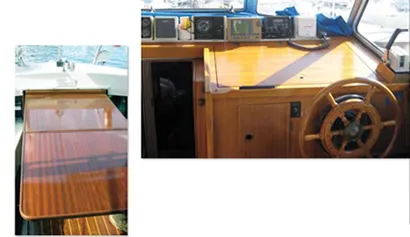
Photos by Ron Dwelle
Danish company LM (Lunderskov Mbelfabrik) began as a wood-furniture maker in 1940. In the 1950s, the company started incorporating the newfangled fiberglass into its furniture and changed its name to LM Glasfiber.
In 1972, the company built its first fiberglass sailboat, the LM27, and over the next 20 years, it built 3,000 boats in five models, ranging from 24 to 32 feet. In 1995, LM stopped building boats and concentrated on fabricating giant wind-turbine blades. The manufacturer is now known as the LM Wind Power Group and claims to be the worlds largest maker of the blades. Unfortunately, the company no longer has anything to do with LM sailboats.
Most LM boats were sold in Europe, but for several years in the 1980s, about a fourth of their hulls were sold in the U.S., particularly in the Great Lakes and East Coast areas. A drastic change in the currency exchange rate raised their price significantly, ending imports. The importer was located in Green Bay, Wis., but went out of business in 2001.
LM reportedly sold the hull molds to English company ScanYachts, which built only two or three hulls, one as recently as 2004.
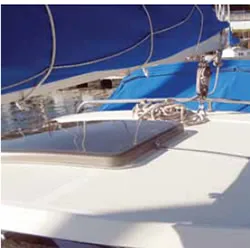
All the LM models share a similar look-canoe-stern hulls with a pilothouse ahead of a sizable cockpit. All are mast-head rigged sloops, and every owner we talked to said that the boats sailed better than they expected-an experience that we shared on our test sail of the LM32. Despite the boats appearance, owners don’t regard them as motorsailers. The smallest model-the LM24-looks a little clunky with the pilothouse, but all the larger models are fairly attractive, with a modest sheer and fairly low cabinhouse and pilothouse. The LM24 was one of the few small boats with a 6-foot standing headroom. The LM27 gained a reputation as an exceptionally good, small ocean passagemaker, and it continues to be in high demand on the European used-boat market.
All LM boats came with a very complete list of standard equipment, including lifelines, pulpits, speedometer, depthsounder, boarding ladders, anchor and rode, fenders, fire extinguishers, and even dishes and cutlery.
The LM24 and LM27 have shallow full-length keels, but the other models were available with twin bilge keels in addition to the more common long-ish fin keel. As far as we know, no bilge-keel models were imported to the U.S., although this was the most popular in England. The fin-keel models have a spade rudder behind a small partial skeg. Ballast in the smaller models was cast iron, and the company said that the larger models had an alloy of iron and lead cast in fiberglass. We havent been able to decipher that claim, but the ballast is enclosed in fiberglass, which is integral to the hull.
All of LMs designers were in-house, and they were referred to as the back-room boys. The designer of the LM24 is listed simply as LM. The LM27 was designed by Palle Mortensen, and the other three models were designed by Bent Juul Andersen.
The boats were sold with either a Bukh (German) or a Volvo (Swedish) diesel. All the LM boats imported to the U.S. came with Volvo engines, while most of the European boats had the Bukh. The Volvo featured a saildrive as standard in the LM30 and LM32. The engines are enclosed in a sound-proofed fiberglass box, either underneath the sole of the pilothouse (LM32) or under the sole of the cockpit (LM30). Many of these boats on the used-boat market have been re-powered with a variety of engines.
The LMs construction is conventional but well done. The boats have a reputation in Europe for high quality, and the LM32 we tested bore out that reputation. The hull is hand-laid fiberglass, and the deck is balsa cored. Its noteworthy that we could find no delamination or spongy spots in the deck or top of the pilothouse in the 28-year-old LM32 we tested-a rarity in a boat of that age.
The interior mahogany woodwork is well done, as you might expect from a company with a long history as a furniture maker. Even the cabinets and drawers are noticeably well-made, evidence that the company didnt skimp on what was out of sight.
The 32 shares all the obvious characteristics of the LM line-particularly the distinctive canoe stern and pilothouse. In most respects, it is simply a larger version of the smaller models. The boat is 32 feet in length and has a 27-foot, 10-inch waterline; its beam is 10 feet 8 inches, and it draws 4 feet, 11 inches. The bilge keel models (called twin-keel in some brochures) draw 4 feet, 1 inch. Displacement is 12,000 pounds, with 4,400 pounds of ballast.
Accommodations
The LM32s cockpit is sizable considering that canoe-stern boats usually have shortened cockpits. There are bench seats on each side of the cockpit, and a large fold-out table easily can seat six. The boat came standard with a canvas bimini that covers the cockpit, and the boat we sailed had zip-in side curtains as well.
There are lockers under each of the bench seats-propane tanks on the port side-and a huge locker under the cockpit sole. Cockpit drains are adequately sized, but they could become a problem with boarding seas from astern, especially since there is no bridgedeck between the cockpit and pilothouse.
At the top of the rudder-stock is an attachment spot for the removable tiller, which can be used if you want to sail from the cockpit rather than from the pilothouse. The wheel steering in the pilothouse has a mechanical disconnect so the tiller moves freely. It would be a challenge to get at the steering gear near the rudder post since the compartment is sealed off from the rest of the cockpit and there are only two round, 6-inch access ports.
At the forward end of the bench seats on each side are the halyard and reefing lines, which run inside a channel on the side of the pilothouse and terminate in cam cleats in front of stainless Andersen winches. The Andersen genoa winches are adequate but definitely not oversized. None of the winches on the test boat were self-tailing; self-tailers were not originally offered as an option.
The mainsheet has a single cam-cleat attachment point at the back edge of the pilothouse, and the sheet hangs down into the cockpit. Theres no mainsheet traveller.
At the front of the cockpit, double sliding doors open up to the pilothouse. On the starboard side is the steering station with a raised captains seat and a second fold-up seat that slides out so two people can share the helm. A wood steering wheel is immediately ahead, and engine controls, the electrical panel, and sailing instruments are directly in front of the helmsman.
The chart table is immediately ahead of the wheel. This setup is good for laying down a chart so the helmsman can see it, but it made it difficult to do actual chart work.
The pilothouses front windows have windshield wipers, and the front center window opens up for ventilation. An interesting feature testers noted was a sliding hatch above the wheel and seat that allows the helmsman to stand up for a good view of the sails, deck, and seas.
On the port side of the pilothouse is a compact galley, with a two-burner propane stove and a small sink. On the test boat, the front-loading refrigerator is underneath the stove, and storage drawers extend all the way outboard to the hull. The only usable counterspaces are the hinged wood covers for the stove and sink, which can be moved when the stove or sink are in use. This may be the smallest galley in any 32-foot production sailboat.
The pilothouse steps down into the saloon, which has a settee on the port side and a dinette/double-berth to starboard. The owner of the boat we sailed had removed the dinette table, opting to eat only at the cockpit table in exchange for a roomier saloon. Stowage lockers are outboard of the 6-foot-long settees as well as underneath. An overhead hatch and a single, fixed port on each side offer good lighting.
Forward of the saloon is the head to starboard, with a hanging locker opposite. The compact head compartment is unusual in that the sink slides out from underneath the deck, above the toilet. The small head also has a teak grating above the sump, making it possible to shower in the head. Fixed ports on each side offer lighting.
The V-berth uses a filler to make a roomy double bed, though it is only 6 feet long. Small stowage lockers are at the head of the V-berth and underneath the anchor locker. There are also shelves along the hull above the berth. Two fixed ports on the side and an overhead front hatch provide adequate lighting. Early models had stacked berths that looked suitable mostly for children, but we don’t think any of those were imported to the U.S.
Overall, with its narrow beam, long cockpit, and canoe stern, the LM32s interior room is comparable to a more-modern, broad-beamed, fat-stern 28-footer. At least LM avoided the folly of quarter-berths, which are wasted space on most boats this size. This is definitely a couples boat, and finding living or sleeping space for four people would be a push.

The rig is a conventional, single-spreader masthead sloop. The chainplates are close to the deckhouse, so the sidedecks are adequately wide, except at the back edge of the pilothouse, where it is a squeeze to get through.
A rigid boom-vang was standard for the LM32 mainsail, making up some for the lack of a traveller. A 150-percent furling genoa also was standard; smaller sails and a spinnaker were options. The boat we test sailed had only the standard main and 150, but had recently added a stack pack for mainsail handling.
Anyone buying a saltwater LM will want to scrutinize the rigging and chainplates carefully for corrosion. The boat we tested was a freshwater boat with zero rig issues after 28 years.
The LM32 engine is a Volvo MD17 three-cylinder, 35-horsepower diesel. Its plenty big to push the boat, even through headwinds and waves. The Volvo saildrive makes for a compact installation, and the entire engine/drive unit is contained in a waterproof and soundproofed compartment underneath the pilothouse sole. Testers noted that the engine was quiet and its installation offered good access.
The aluminum saildrive needs to be maintained carefully if used in saltwater, but weve heard of surprisingly few problems with corrosion or with the rubber hull seal. The saildrive came with a fixed prop-a folding prop being optional-and the boat we tested had the fixed. Performance would benefit from a folding prop.
On the LM32, the prop is well forward of the rudder, making the boat less maneuverable in reverse. Theres also little sidewise kick from the prop, so tight-quarter turning will be a challenge. In the LM30, the saildrive is much closer to the rudder-under the cockpit rather than under the pilothouse.
Original fuel tankage on the LM32 was 55 gallons, more than enough for normal cruising. In fact, were not big fans of such large tankage. Most coastal cruisers will eventually have fuel in the tank that is several years old, and this could lead to potential problems with algae and other contaminants.
The 55 gallons of water tankage is also adequate for coastal cruising, but the holding tank is only 15 gallons, and this could be an issue as states increase enforcement of pump-out rules. Unfortunately, there is no good place on the boat to install a larger tank.
The original electrical wiring was well done, although after 25 years there are almost always some cobbled-up wiring runs, and the breaker panel would benefit from expansion. The boat comes standard with four 90-amp batteries-housed directly ahead of the engine compartment underneath the pilothouse sole-and shorepower wiring.
The boat also came standard with basic sailing instruments-except a wind meter-and all were still working on the boat we sailed. A wheel-mounted autopilot was installed in the pilothouse. Most owners will want to upgrade to more modern instruments.
The standard deck hardware was satisfactory, in our opinion. Theres a small bowsprit, and our test boat carried a 33-pound Bruce anchor. The anchor locker offers plenty of room for adequate rode. The boat we tested had all chain rode and a windlass. Second and third anchors would have to be stowed in cockpit lockers.
As we noted, the sidedecks and toe-rail are acceptable, being skinny only at the back edge of the pilothouse, but testers did have a problem climbing up on top of the pilothouse-something that you would not do often anyway. The boarding ladder at the canoe stern could be a challenge for some, since theres so little deck space back there, but its do-able.
We were pleasantly surprised by the sailing ability of the LM32. With its pilothouse and canoe stern, you might expect it to sail like a motor sailor, but its nimble and relatively quick, much like a conventional modern sloop.
Conditions for our test sails were 8- to 10-knot winds, and later 10 to 14 knots winds, in relatively flat water, so we sailed with a full main and the 150-percent jib. Both Dacron sails were in excellent shape, of recent vintage. The LM32 sailed nearly to hull speed in the light air and definitely to hull speed in the heavier air.
She came about quickly and tacked easily through 90 degrees. Off the wind, she did very well on close and beam reaches, slowing down only when the wind went more than 120-degrees apparent. You wouldnt need a reef in the main until about 15 knots. Though narrow, the LM32 is a pretty stable boat.
Testers found steering from the pilothouse to be tricky. The sheets and other sail controls are all in the cockpit, behind the pilothouse, so the helmsman has to leave the helm to handle the sails or depend on crew.
The boat can be sailed from the cockpit, using the attachable tiller, but visibility is poor from the cockpit seats-the helmsman would have to stand up to steer the boat. For cruising, the autopilot would ease this problem, but most experienced sailors would have to adjust to the pilothouse.
LM boat owners seem to hold on to their boats for a long time. At presstime, 15 LMs were listed for sale in Europe, but only one was listed in the U.S. And the only boat sold in the U.S. in the previous year that we could find was actually exported to Europe. Prices varied from $43,000 to $73,000, which we think is very expensive for this size boat.
The appeal of LM boats is definitely in their appearance. If you like a pilothouse and the idea of a canoe stern, this boat is worth considering. Its well-made and sails well, better than most motorsailers we know. We would be hesitant to take one offshore (though a number have made long passages), but it would be a good coastal cruiser.
RELATED ARTICLES MORE FROM AUTHOR
Bukh is danish;-)
Good morning Recently I’ve bought a LM 32, the previous owner give me a very short documentation, thus I have some doubts. 1) How disconnect the whell steering for pilot with free tiller. 2) Do you Know if tfis LM 32 has black water reservoir? Thanks a lot
1) In the pilot house just left of the electrical switches is a T-bar to pull. This will disconnect the steering wheel. Reconnecting can be tricky, since both have to be well aligned. 2) Yes in the floor of the V-birth in the bow.
Happy sailing!
Dear Bart, These problems are solved, now I have another with the steering unit because has too much play. Do you know where can I shop ones? Thanks a lot.
I’ve had my LM 32 since the late 1980’s and sailed this boat through some of the roughest weather the Great Lakes could dish out with surprising safety. So far there have been no major malfunctions ! True it has been stored inside and well maintained, but frankly I’m impressed !
LEAVE A REPLY Cancel reply
Log in to leave a comment
Latest Videos

What’s The Best Vinyl Window Cleaner for Your Boat?


40-Footer Boat Tours – With Some Big Surprises! | Boat Tour

Electrical Do’s and Don’ts

Bahamas Travel Advisory: Cause for Concern?
- Privacy Policy
- Do Not Sell My Personal Information
- Online Account Activation
- Privacy Manager

LM 32 similar search results:
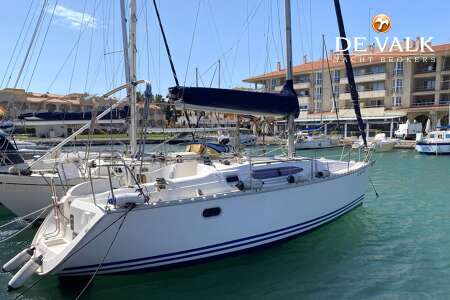
JEANNEAU SUN ODYSSEY 32.2
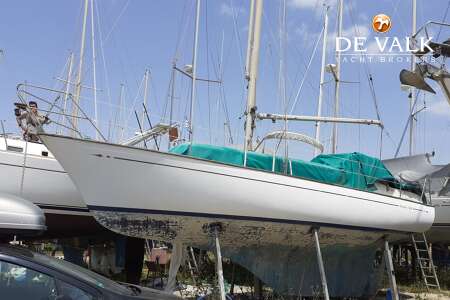
CLASSIC SAILING YACHT
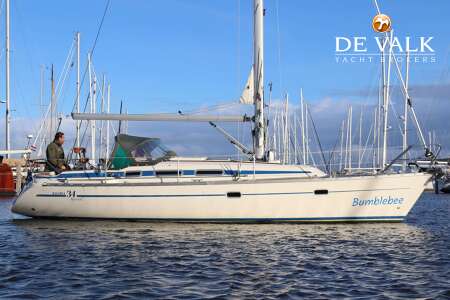
BAVARIA 34 SPEED
The lm 32 shown below has been sold:.

Sales information
- De Valk Sint Annaland The Netherlands
- +31 166 601 000
- Call the broker
e-mail the broker
Tell a friend.
- download brochure
Take time onboard with a live video tour
Seen a boat that piques your interest but can't make a visit in person? One of our brokers will be your eyes and ears as they take you on a video tour with their phone. You can also ask them questions about anything that isn't visually obvious. Make the call and be welcomed aboard...
Download brochure
Broker's comments.
Popular motorsailer with good sailperformance and pilothouse. LM have been building yachts ranging from 16 till 38 feet, where they mixed the typical motorsailer characteristics (pilothouse, space and comfort) with a well balanced, easy to handle sailplan. Comes well equipped with upgraded electronics, bowthruster, heating.
General - LM 32
GRP motorsailer LM 32 "Brandane", built in 1978 by LM Glassfiber AS Denmark, dim.: 9,75 (lwl 8,50) x 3,25 x 1,50 mtr, headway above waterline: 14,50 mtr, grp hull, deck and superstructure, teak in cockpit, windows in aluminium frames, roundbilged hull with rubbingstrake, fin keel, balanced rudder in skeg, displacement; 6 tonnes, ballast: 2,2 tonnes (lead & cast iron), fueltank: 250 ltrs (grp), freshwatertank: 250 ltrs (grp), sumptank prepared (fittings in place), mechanical wheelsteering in pilothouse, tiller steering in cockpit. Helmpositon in pilothouse has a slide-out/fold-away extra seat.
Accommodation
Classic mahogany interior, 1 cabin and salon, pilothouse, 2(+3) berths, V-berth forward, dinette (can be converted into double berth, headroom: 1,95 mtr, settee, 1 x uw toilet and washbasin, Eberspaecher D3L diesel ducted hot air heating. Galley in pilothouse with stainless steel sink, washbasin and two burner gasstove, electric waterpressure system, boiler hot water system (on engine), 12v Danfoss compressor frontloading fridge.
Volvo Penta MD17C 36 hp (26kW) diesel, installed in 1978, indirect coolingsystem, Volvo Penta Saildrive (seal renewed in 2005), three bladed propeller, cruisingspeed approx. 6 knots, consumption approx. 2,5 ltr/hr, manual / electric bilgepumps, 12/220v electrical system (overhauled in 2003), 4 x battery (2010), shorepower, Mastervolt 12/40 amp automatic batterycharger (2003). Vetus 55kgf electric bowthruster.
Silva compass, Raymarine ST60 log, echosounder and windset, Raymarine Ray54E VHF, Raymarine ST5000+ autopilot (with remote control), VDO Logic Map 10 colour chartplotter and gps, Furuno GP-32 gps (most navigational equipment renewed 2003-04)
Grundig colour TV, Grundig radio/cd player, cockpitcover (winter+summer), cockpittable and -cushions, pilothouse with slidingdoors to cockpit and twin helmsman seat, Goiot manual anchorwinch, Plough anchor with chain, lifebuoy, windscreenwipers, fenders, mooringlines, clock, barometer.
Sloop-rigged, Francespar aluminium mast, Goiot genoa furler, 4 sails: full batten main with Lazy Jacks (+spare) / 2 x furling genoa / stormjib, slabreefing for main (from cockpit), mainsail cover, cover for furling genoa, 2 x Lewmar ST43 sheetwinches, 2 x Lewmar 16ST halyardwinches, spi-pole stowed at the mast, tackle boomvang, mechanical backstayadjuster.
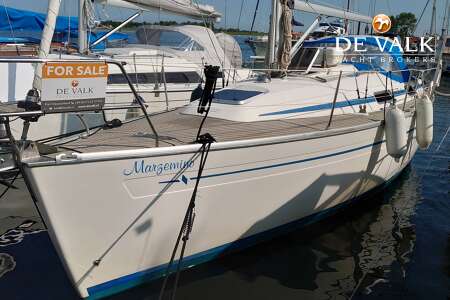
The Lm 32 is a 32.0ft masthead sloop designed by Bent Juul Andersen and built in fiberglass by LM Glasfiber (DEN) between 1977 and 1988.
181 units have been built..
The Lm 32 is a moderate weight sailboat which is slightly under powered. It is stable / stiff and has a good righting capability if capsized. It is best suited as a bluewater cruising boat.
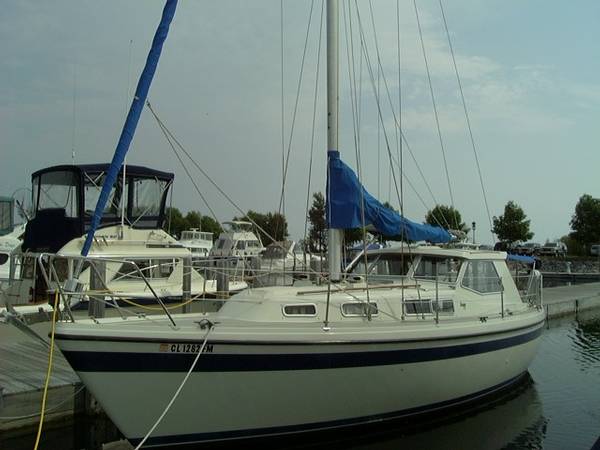
Lm 32 for sale elsewhere on the web:

Main features
Login or register to personnalize this screen.
You will be able to pin external links of your choice.

See how Sailboatlab works in video

We help you build your own hydraulic steering system - Lecomble & Schmitt
Accommodations
Builder data, modal title.
The content of your modal.
Personalize your sailboat data sheet
Review of LM 32
Basic specs..
LM 32 is typically equipped with an inboard Bukh DV36 SME diesel engine.
The fuel tank has a capacity of 250 liters (66 US gallons, 54 imperial gallons).
Sailing characteristics
This section covers widely used rules of thumb to describe the sailing characteristics. Please note that even though the calculations are correct, the interpretation of the results might not be valid for extreme boats.
What is Capsize Screening Formula (CSF)?
The capsize screening value for LM 32 is 1.77, indicating that this boat could - if evaluated by this formula alone - be accepted to participate in ocean races.
What is Theoretical Maximum Hull Speed?
The theoretical maximal speed of a displacement boat of this length is 7.1 knots. The term "Theoretical Maximum Hull Speed" is widely used even though a boat can sail faster. The term shall be interpreted as above the theoretical speed a great additional power is necessary for a small gain in speed.
The immersion rate is defined as the weight required to sink the boat a certain level. The immersion rate for LM 32 is about 185 kg/cm, alternatively 1036 lbs/inch. Meaning: if you load 185 kg cargo on the boat then it will sink 1 cm. Alternatively, if you load 1036 lbs cargo on the boat it will sink 1 inch.
Sailing statistics
This section is statistical comparison with similar boats of the same category. The basis of the following statistical computations is our unique database with more than 26,000 different boat types and 350,000 data points.
What is Motion Comfort Ratio (MCR)?
What is L/B (Length Beam Ratio)?
What is Displacement Length Ratio?
What is SA/D (Sail Area Displacement ratio)?
What is Relative Speed Performance?
Maintenance
Are your sails worn out? You might find your next sail here: Sails for Sale
If you need to renew parts of your running rig and is not quite sure of the dimensions, you may find the estimates computed below useful.
This section shown boat owner's changes, improvements, etc. Here you might find inspiration for your boat.
Do you have changes/improvements you would like to share? Upload a photo and describe what to look for.
We are always looking for new photos. If you can contribute with photos for LM 32 it would be a great help.
If you have any comments to the review, improvement suggestions, or the like, feel free to contact us . Criticism helps us to improve.
Great choice! Your favorites are temporarily saved for this session. Sign in to save them permanently, access them on any device, and receive relevant alerts.
- Sailboat Guide
LM 32 is a 31 ′ 11 ″ / 9.8 m monohull sailboat designed by Bent Juul Andersen and built by LM Glasfiber between 1977 and 1988.
Rig and Sails
Auxilary power, accomodations, calculations.
The theoretical maximum speed that a displacement hull can move efficiently through the water is determined by it's waterline length and displacement. It may be unable to reach this speed if the boat is underpowered or heavily loaded, though it may exceed this speed given enough power. Read more.
Classic hull speed formula:
Hull Speed = 1.34 x √LWL
Max Speed/Length ratio = 8.26 ÷ Displacement/Length ratio .311 Hull Speed = Max Speed/Length ratio x √LWL
Sail Area / Displacement Ratio
A measure of the power of the sails relative to the weight of the boat. The higher the number, the higher the performance, but the harder the boat will be to handle. This ratio is a "non-dimensional" value that facilitates comparisons between boats of different types and sizes. Read more.
SA/D = SA ÷ (D ÷ 64) 2/3
- SA : Sail area in square feet, derived by adding the mainsail area to 100% of the foretriangle area (the lateral area above the deck between the mast and the forestay).
- D : Displacement in pounds.
Ballast / Displacement Ratio
A measure of the stability of a boat's hull that suggests how well a monohull will stand up to its sails. The ballast displacement ratio indicates how much of the weight of a boat is placed for maximum stability against capsizing and is an indicator of stiffness and resistance to capsize.
Ballast / Displacement * 100
Displacement / Length Ratio
A measure of the weight of the boat relative to it's length at the waterline. The higher a boat’s D/L ratio, the more easily it will carry a load and the more comfortable its motion will be. The lower a boat's ratio is, the less power it takes to drive the boat to its nominal hull speed or beyond. Read more.
D/L = (D ÷ 2240) ÷ (0.01 x LWL)³
- D: Displacement of the boat in pounds.
- LWL: Waterline length in feet
Comfort Ratio
This ratio assess how quickly and abruptly a boat’s hull reacts to waves in a significant seaway, these being the elements of a boat’s motion most likely to cause seasickness. Read more.
Comfort ratio = D ÷ (.65 x (.7 LWL + .3 LOA) x Beam 1.33 )
- D: Displacement of the boat in pounds
- LOA: Length overall in feet
- Beam: Width of boat at the widest point in feet
Capsize Screening Formula
This formula attempts to indicate whether a given boat might be too wide and light to readily right itself after being overturned in extreme conditions. Read more.
CSV = Beam ÷ ³√(D / 64)
Single and Bilge keels. Similar to LM 30.
Embed this page on your own website by copying and pasting this code.
- About Sailboat Guide
©2024 Sea Time Tech, LLC
This site is protected by reCAPTCHA and the Google Privacy Policy and Terms of Service apply.

NEW LISTING – 1979 LM32 ‘ARGOSY III’
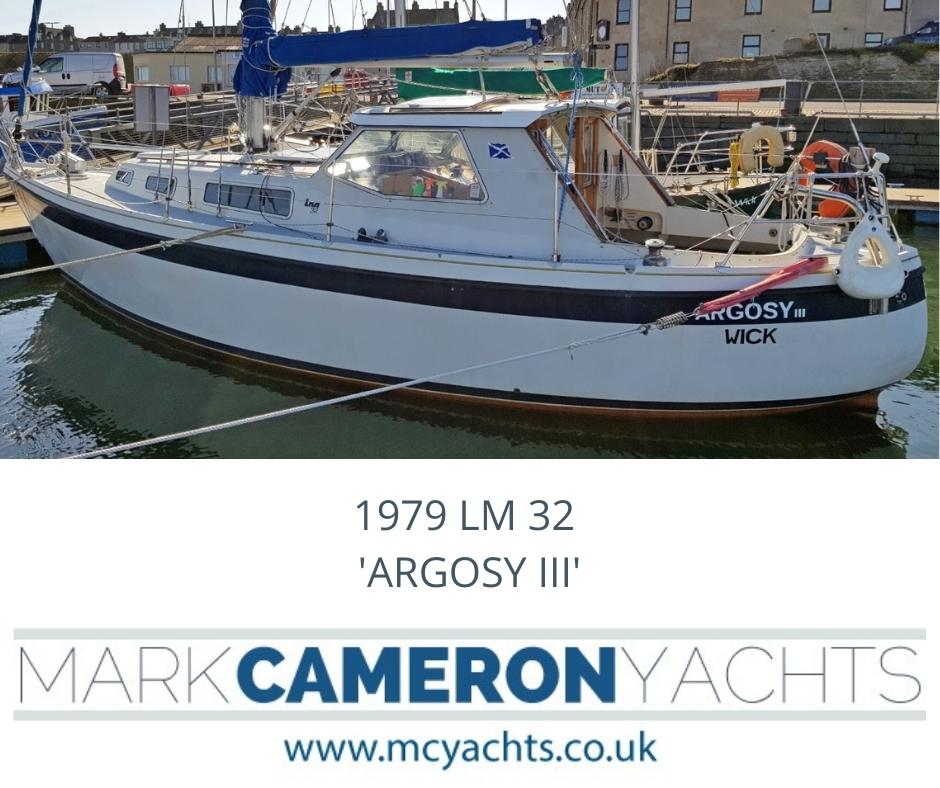
Tuesday 22nd March 2022
Mark Cameron Yachts are delighted to have been appointed to act in the sale of the 1979 LM32 ‘ARGOSY III’.
The Danish company LM (Lunderskov Mbelfabrik) was established in the 1940’s as a manufacturer of wooden furniture. In years that followed the company moved with the times, incorporating fiberglass initially in to the design and construction of its furniture before changing its name to LM Glasfiber and starting to build GRP boats. Introduced in 1972 with LM27 firmly established the companies offering with all subsequent models sharing the same design features, canoe stern and pilot house forward of a large open cockpit. Before ceasing boat production in 1995 to diversify again; into the manufacture of wind turbine components, the company had produce a total of approximately 3000 boats in four different models L M24, LM27, LM30 and the LM32.
The LM32 is the largest model in the line up, introduced in 1977 the model remain in production through until the late 1980s with around 200 boats built. With her large cockpit aft and open backed pilot house she offers both tiller and undercover wheel steering options. Below decks 4 single berths are provided between the saloon and forward cabin. An early example of the LM32 class ARGOSY is not reluctantly offered for sale, her highlights including:
- Original Dove grey gelcoat to finish topsides and coachroof
- Bukh DV36 SME marine diesel engine
- Bukh saildrive unit
- Vetus Bow Thurster 55kgf
- 12VDC onboard power system
- 230VAC shore power system
- 230VAC – 12VDC Battery Charger
- Solar panel
- Black water tank with electric pump discharge
- Navico DS200 echosounder
- Sumlog Speed and Log instrument
- Tactick MN100-2 Wind Instrument
- Garmin GPSMAP 182C plotter
- Icom IC-M411 DSC VHF
- Eberspacher D5 Airtronic heater
- Gas galley stove
- Lofrans Cayman 88 windlass, 1000w electric windlass
- 2.3m Waveco inflatable dinghy (2017)
- Stainless steel swivelling tubular davits
Lying afloat in Wick, Caithness, Scotland the LM32 ARGOSY is available for viewing by prior appointment.
FIND FULL DETAILS OF THE LM 32 ‘ARGOSY III’ HERE
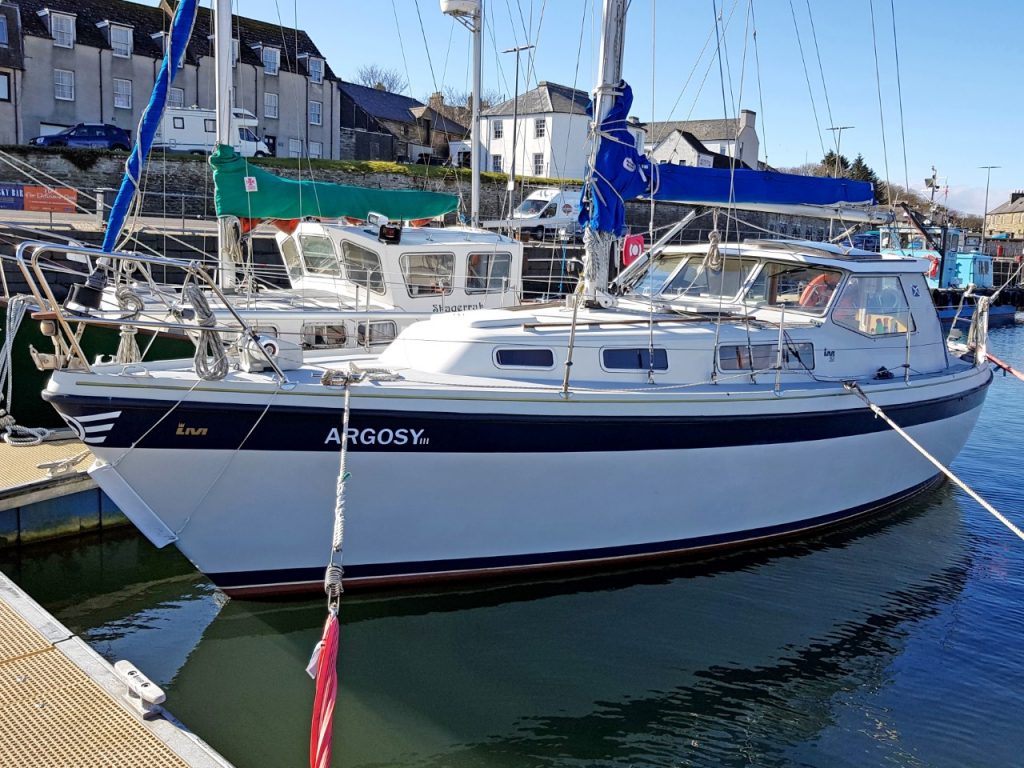
1979 LM32 ‘ARGOSY III’
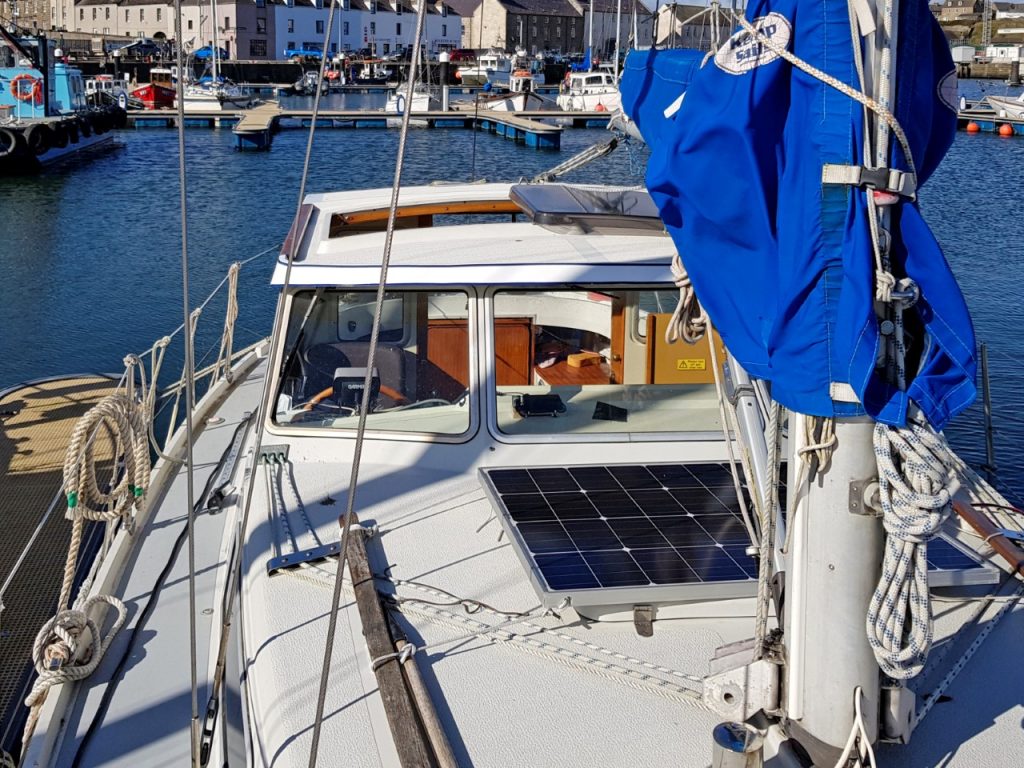
- Privacy Overview
- Strictly Necessary Cookies
- 3rd Party Cookies
- Cookie Policy
This website uses cookies so that we can provide you with the best user experience possible. Cookie information is stored in your browser and performs functions such as recognising you when you return to our website and helping our team to understand which sections of the website you find most interesting and useful.
Strictly Necessary Cookie should be enabled at all times so that we can save your preferences for cookie settings.
If you disable this cookie, we will not be able to save your preferences. This means that every time you visit this website you will need to enable or disable cookies again.
This website uses Google Analytics to collect anonymous information such as the number of visitors to the site, and the most popular pages.
Keeping this cookie enabled helps us to improve our website.
Please enable Strictly Necessary Cookies first so that we can save your preferences!
For more information on Cookies, please see our Cookie Policy page
LM 32 Detailed Review
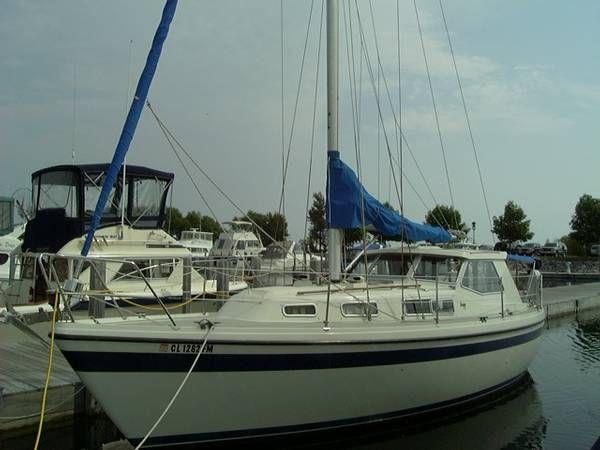
If you are a boat enthusiast looking to get more information on specs, built, make, etc. of different boats, then here is a complete review of LM 32. Built by LM Glasfiber (DEN) and designed by Bent Juul Andersen, the boat was first built in 1977. It has a hull type of Long Keel and LOA is 9.75. Its sail area/displacement ratio 14.50. Its auxiliary power tank, manufactured by Volvo, runs on Diesel.
LM 32 has retained its value as a result of superior building, a solid reputation, and a devoted owner base. Read on to find out more about LM 32 and decide if it is a fit for your boating needs.
Boat Information
Boat specifications, sail boat calculation, auxillary power tank, contributions, who designed the lm 32.
LM 32 was designed by Bent Juul Andersen.
Who builds LM 32?
LM 32 is built by LM Glasfiber (DEN).
When was LM 32 first built?
LM 32 was first built in 1977.
How long is LM 32?
LM 32 is 8.49 m in length.
Member Boats at HarborMoor

IMAGES
VIDEO
COMMENTS
The LM32. The 32 shares all the obvious characteristics of the LM line-particularly the distinctive canoe stern and pilothouse. In most respects, it is simply a larger version of the smaller models. The boat is 32 feet in length and has a 27-foot, 10-inch waterline; its beam is 10 feet 8 inches, and it draws 4 feet, 11 inches.
S# first appeared (that we know of) in TellTales, April 1988, “On a Scale of One to Ten” by A.P. Brooks . The equation incorporates SA/Disp (100% fore triangle) and Disp/length ratios to create a guide to probable boat performance vs. other boats of comparable size. For boats of the same length, generally the higher the S#, the lower the PHRF.
General - LM 32. GRP motorsailer LM 32 "Brandane", built in 1978 by LM Glassfiber AS Denmark, dim.: 9,75 (lwl 8,50) x 3,25 x 1,50 mtr, headway above waterline: 14,50 mtr, grp hull, deck and superstructure, teak in cockpit, windows in aluminium frames, roundbilged hull with rubbingstrake, fin keel, balanced rudder in skeg, displacement; 6 tonnes ...
The Lm 32 is a 32.0ft masthead sloop designed by Bent Juul Andersen and built in fiberglass by LM Glasfiber (DEN) between 1977 and 1988. 181 units have been built. The Lm 32 is a moderate weight sailboat which is slightly under powered. It is stable / stiff and has a good righting capability if capsized. It is best suited as a bluewater ...
The Relative Speed Performance for LM 32 is 18. Slow Fast 18% 0 50 100. The relative speed performance is 18 which means that a it is faster than 18% of all similar sailboat designs. As this boat is a motor sailer, it is expected that the performance of a motor sailer for sail alone is lower than a dedicated sailboat.
LM 32 is a 31′ 11″ / 9.8 m monohull sailboat designed by Bent Juul Andersen and built by LM Glasfiber between 1977 and 1988. ... The lower a boat's ratio is, the ...
Find LM 32 boats for sale in your area & across the world on YachtWorld. Offering the best selection of LM boats to choose from.
Mark Cameron Yachts are delighted to have been appointed to act in the sale of the 1979 LM32 ‘ARGOSY III’. The Danish company LM (Lunderskov Mbelfabrik) was established in the 1940’s as a manufacturer of wooden furniture. In years that followed the company moved with the times, incorporating fiberglass initially in to the design and ...
Find 24 LM 32 for sale on YachtWorld Europe's largest marketplace for boats & yachts. We connect over 10 million boat buyers and sellers each year!
LM 32 Detailed Review. 1 of 1. If you are a boat enthusiast looking to get more information on specs, built, make, etc. of different boats, then here is a complete review of LM 32. Built by LM Glasfiber (DEN) and designed by Bent Juul Andersen, the boat was first built in 1977. It has a hull type of Long Keel and LOA is 9.75.